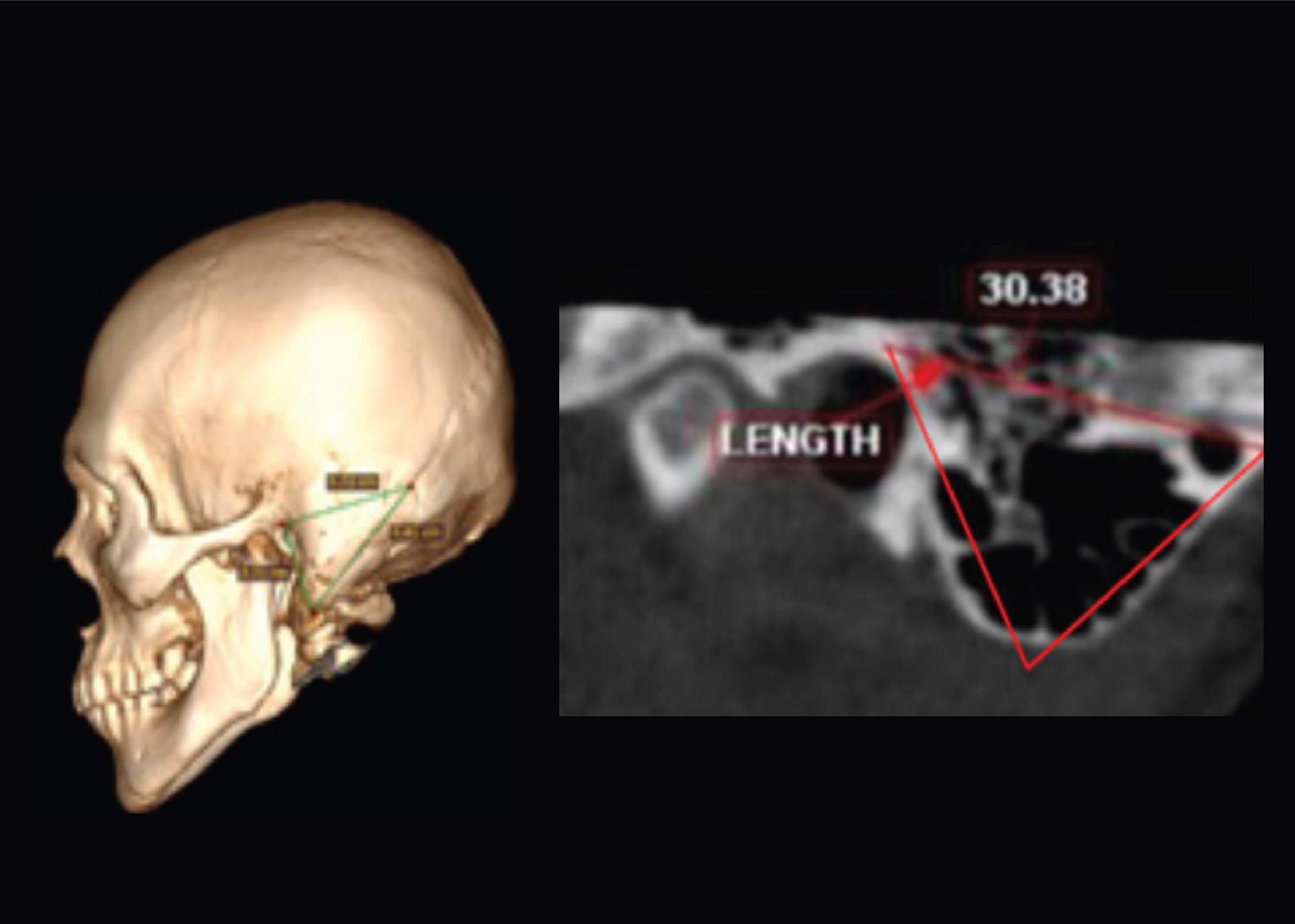COMPARATION OF MASTOID TRIANGLE AREA MEASUREMENT TECHNIQUES USING VOLUME RENDERING POST PROCESSING AND MULTI PLANAR REFORMATION

Downloads
Background: Identification in the anthropology of the forensic world using radiographic methods can be evaluated from variations in the human skeleton. The skull is the most dimorphic part of the skeleton, precisely in the temporal bone, namely the mastoid process. The use of advanced radiological technology in the evaluation of the mastoid process in humans can be done using the CT scan modality. Purpose: To determine the measurement results of the total area of the mastoid triangle using post processing volume rendering and multi planar reformation. Method: This type of research is an analytic observational study with a retrospective approach. The number of samples used were 152 raw data of patients with criteria aged 26-65 years and without any pathological changes in the mastoid process area. This research uses simple random sampling technique. Measurements were carried out 10 times by using 2 gauges, and using 3D slicer software on volume rendering and multi planar reformation reconstruction data. Data were analyzed using the free sample T test. Result: Measurer A produces total area of mastoid triangle using volume rendering is 1165.72 ± 1.2506 and multi planar reformation is 1145.84 ± 1.46512, with a significance value of 0.204 (p > 0.05). Similar results were obtained by measuring B. Measurer A produced a total area of mastoid triangle using volume rendering is 1159.91 ± 1.29691 and an multi planar reformation is 1146.56 ± 1.4606, with a significance value of 0.400 (p > 0.05). Conclusion:The results indicated that there was no significant difference in the results of measuring the total area of mastoid triangle using post processing volume rendering and multi planar reformation.
Ahmed, A., Gataa, I.S., M, F.S., 2015. CT Scan Images Analysis of Maxillary Sinus Dimensions as A Forensic Tool for Sexual and Racial Detection in A Sample of Kurdish Population. Eur. Sci. J. 11.
Allam, F.A.F.A.B., Allam, M.F.A.B., 2016. Sex Discrimination of Mastoid Process by Anthropometric Measurements using Multidetector Computed Tomography in Egyptian Adult Population. Egypt. J. Forensic Sci. 6, 361–369.
Bhayya, H., Tejasvi, M.L.A., B., J., M., M.R., 2018. Craniometric Assessment of Gender using Mastoid Process. J. Indian Acad. Oral Med. Radiol. 30, 52–57.
Bilfeld, M.F., Dedouit, F., Rousseau, H., Sans, N., Braga, J., Rougé, D., Norbert, T., 2011. Human Coxal Bone Sexual Dimorphism and Multislice Computed Tomography: Geometric Morphometric Analysis of 65 Adults. Forensic Sci. 57.
Biwasaka, H., Aoki, Y., Tanijiri, T., Sato, K., Fujita, S., Yoshioka, K., Tomabechi, M., 2009. Analyses of Sexual Dimorphism of Contemporary Japanese using Reconstructed Three-dimensional CT Images-Curvature of The Best- fit Circle of The Greater Sciatic Notch. Leg. Med. 11, 260–262.
Chen, J.Y., Mafee, M.F., 2014. Computed Tomography Imaging Technique and Normal Computed Tomography Anatomy of The Temporal Bone. Oper. Tech. Otolaryngol. 25, 3–12.
de Paiva, L.A.S., Segre, M., 2003. Sexing The Human Skull Through The Mastoid Process. Rev. Hosp. Clin. Fac. Med. Sao. Paulo. 58, 15–20.
Depkes, 2009. Klasifikasi Umur menurut Kategori [WWW Document]. Dep. Kesehat. RI.
Dofe, M.Y., Nemade, K.S., Kamadi, N.Y., 2020. Morphometric Study on Mastoid Process for Determination of Sex by Using 3D CT Scan. Indian J. Anat. 9, 85–89.
Gaayathri, D.D., Kanmani, R., Anandi, Kannan, A., Raghuram, 2017. Case Study Role of Mastoid Process in Gender Determination - A Retrospective Analysis using Computed Tomography. Int. J. Curr. Res. 9, 57323–57326.
Mazziotti, S., Blandino, A., Gaeta, M., Bottari, A., Sofia, C., D'Angelo, T., Ascenti, G., 2015. Postprocessing in Maxillofacial Multidetector Computed Tomography. Can. Assoc. Radiol. J. 66, 212–222.
Suazo Galdames, I.C., Zavando Matamala, D.A., Smith, R.L., 2008. Determinación del Sexo usando Mediciones en el Proceso Mastoides en Cráneos Brasileños. Int. J. Morphol. 26, 941–944.
Copyright (c) 2020 Journal of Vocational Health Studies

This work is licensed under a Creative Commons Attribution-NonCommercial-ShareAlike 4.0 International License.
- The authors agree to transfer the transfer copyright of the article to the Journal of Vocational Health Studies (JVHS) effective if and when the paper is accepted for publication.
- Legal formal aspect of journal publication accessibility refers to Creative Commons Attribution-NonCommercial-ShareAlike (CC BY-NC-SA), implies that publication can be used for non-commercial purposes in its original form.
- Every publications (printed/electronic) are open access for educational purposes, research, and library. Other that the aims mentioned above, editorial board is not responsible for copyright violation.
Journal of Vocational Health Studies is licensed under a Creative Commons Attribution-NonCommercial-ShareAlike 4.0 International License














































